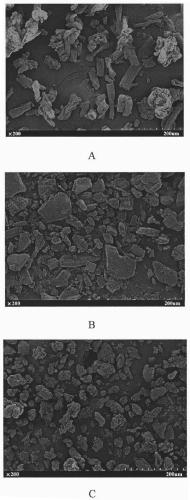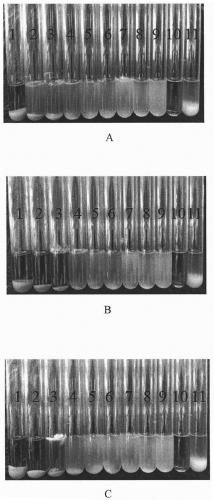Preparation method of dialdehyde cellulose grafted epsilon-polylysine antibacterial material
A technology of dialdehyde cellulose and polylysine, applied in botany equipment and methods, chemicals for biological control, animal repellants, etc., can solve problems such as limiting the scope of application, and achieve wide application and distribution Wide range of antibacterial effect
- Summary
- Abstract
- Description
- Claims
- Application Information
AI Technical Summary
Problems solved by technology
Method used
Image
Examples
Embodiment 1
[0031] (1) Dissolve ε-polylysine in 100mL deionized water, adjust the medium to pH 8.0 with NaOH solution, and add bisaldehyde according to the molar ratio of aldehyde group of dialdehyde cellulose to ε-polylysine 1:0.1. Aldehyde cellulose, and then carry out grafting reaction at 30 ℃ for 8h;
[0032] (2) After the reactor is cooled to room temperature, the filtrate is removed by suction filtration, the filter cake is washed with deionized water and ethanol successively, the obtained graft is naturally air-dried, ground evenly, and then vacuum-dried at 37°C to obtain the graft ε-polylysine antibacterial material.
[0033] (3) antibacterial material is carried out antibacterial experiment to sarcinina;
[0034] The minimum inhibitory concentration (MIC) of the dialdehyde cellulose / ε-PL antibacterial material prepared from dialdehyde cellulose with an aldehyde content of 5.514 mmol / g against Sarcina was 30 mg / mL.
Embodiment 2
[0036] (1) Dissolve ε-polylysine in 100mL deionized water, adjust the medium to pH 8.5 with NaOH solution, and add dialdehyde cellulose according to the molar ratio of aldehyde group of dialdehyde cellulose to ε-polylysine 1:0.1. Aldehyde cellulose, and then carry out grafting reaction at 30 ℃ for 8h;
[0037] (2) After the reactor is cooled to room temperature, the filtrate is removed by suction filtration, the filter cake is washed with deionized water and ethanol successively, the obtained graft is naturally air-dried, ground evenly, and then vacuum-dried at 37°C to obtain the graft ε-polylysine antibacterial material.
[0038] (3) Antibacterial material is carried out antibacterial experiment to Escherichia coli;
[0039] The minimum inhibitory concentration (MIC) of the dialdehyde cellulose / ε-PL antibacterial material prepared from dialdehyde cellulose with an aldehyde content of 5.514 mmol / g against E. coli was 7.5 mg / mL.
Embodiment 3
[0041] (1) Dissolve ε-polylysine in 100mL deionized water, adjust the medium to pH 8.5 with NaOH solution, and add dialdehyde cellulose according to the molar ratio of aldehyde group of dialdehyde cellulose to ε-polylysine 1:0.2 Aldehyde cellulose, and then carry out grafting reaction at 30 ℃ for 8h;
[0042] (2) After the reactor is cooled to room temperature, the filtrate is removed by suction filtration, the filter cake is washed with deionized water and ethanol in turn, the obtained graft is naturally air-dried, ground evenly, and then vacuum-dried at 47°C to obtain the graft ε-polylysine antibacterial material.
[0043] (3) Antibacterial material is carried out antibacterial test to Staphylococcus aureus;
[0044] The minimum inhibitory concentration (MIC) of dialdehyde cellulose / ε-PL antibacterial material against Staphylococcus aureus was 7.5 mg / mL prepared from dialdehyde cellulose with aldehyde group content of 5.514 mmol / g.
PUM
 Login to View More
Login to View More Abstract
Description
Claims
Application Information
 Login to View More
Login to View More - R&D
- Intellectual Property
- Life Sciences
- Materials
- Tech Scout
- Unparalleled Data Quality
- Higher Quality Content
- 60% Fewer Hallucinations
Browse by: Latest US Patents, China's latest patents, Technical Efficacy Thesaurus, Application Domain, Technology Topic, Popular Technical Reports.
© 2025 PatSnap. All rights reserved.Legal|Privacy policy|Modern Slavery Act Transparency Statement|Sitemap|About US| Contact US: help@patsnap.com



